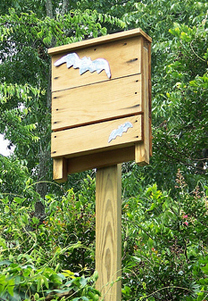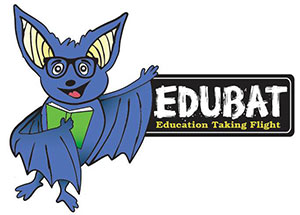Did you know? Maryland is home to 10 species of bats. Bats belong to the order Chiroptera, which means “hand-wing.” Their hand is literally their wing, and they are the only mammals that can fly. Bats are more closely related to people than to mice and like humans, bats have hair, and feed their young milk.
There are over 1,000 species of bats worldwide, compromising around 25% of the world’s mammal diversity. Bats can be split into two groups- the Megachiroptera and the Microchiroptera. Megachiroptera are mostly tropical species that often play a role in pollinating plants as well as fertilizing and dispersing seeds of many plants. Over 300 species of fruits are pollinated by bats. These bats are often referred to as the fruit-eating bats or flying foxes, and they rely on their large eyes and noses to locate food. Microchiroptera make up the other group of bats. Microchiroptera primarily feed on insects and rely on
echolocation to navigate and to locate food. It is estimated that bats provide over $3 billion dollars in pest control services for the United States agricultural industry.
In Maryland, all of our bat species fall into the Microchiroptera group and eat insects such as mosquitos, stinkbugs, moths, and more. We can further subdivide our bats into tree bats and cave bats. In general, tree bats either migrate or spend the winter in tree cavities, under bark, or even under leaf litter. Cave bats tend to hibernate in caves or tunnels. All 10 species of bats occurring in Maryland are considered to be
 Species of Greatest Conservation Need. One major reason for decline of our cave bats is whitenose syndrome which is covered on our
bat disease page.
Species of Greatest Conservation Need. One major reason for decline of our cave bats is whitenose syndrome which is covered on our
bat disease page.
Tree Bats
Eastern red bat (Lasiurus borealis)
Hoary bat (Lasiurus cinereus)
Silver-haired bat (Lasionycterus noctivagans)
Evening bat (Nycticeius humeralis)
Cave Bats
Eastern small-footed bat (Myotis leibii)
Little brown bat (Myotis lucifugus)
Northern long-eared bat (Myotis septentrionalis)
Indiana bat (Myotis sodalis)
Tri-colored bat (Perimyotis subflavus)
Big brown bat (Eptesicus fuscus)
Note: Currently, there are unconfirmed records of Seminole bat (Lasiurus seminolus) and Southeastern bat (Myotis austroriparius) in Maryland.

Got Bats?
Got Bats?
Have you seen bats at your house or in your neighborhood? Bats are commonly misunderstood but extremely important animals in Maryland. Unfortunately, bats in Maryland and in much of the United States are in decline. We would love to know more about Maryland's local bat roosts to assist with their conservation!
For information on creating bat houses, check out our
Bat Box web page.
For information on supporting bats through gardening, visit
Bat Conservation International's page.
Found an Injured or Orphaned Bat?
Any bat, regardless of age, can be rehabilitated. If you should find an injured or potentially orphaned bat, please read the guidelines on our
sick and injured wildlife page and then contact a
licensed wildlife rehabilitator. Never handle a live bat with your bare hands.
For More Information: 
Photo of Eastern red bat by Dr. S. Altenbach
Photo of Bat house by SFAJane, Flickr CC by 2.0
For more information, please contact:
Maryland Department of Natural Resources
Wildlife and Heritage Service
Tawes State Office Building, E-1
Annapolis MD 21401
410-260-8540
Toll-free in Maryland: 1-877-620-8DNR
[email protected]